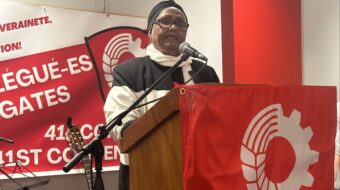Indigenous resistance in Colombia has become a social movement. Colombia’s right wing, U.S. supported government has to deal with that now, plus guerrilla insurgencies and agitation for negotiated peace. The indigenous, guerrillas and leftist opposition parties are all fighting against the take-over of land and subsoil resources by the wealthy few and the Colombian government which supports them.
Indigenous people from throughout Colombia and beyond gathered on August 9 in Popayán, capital of Cauca department in Colombia’s southwest. Some 15,000 indigenous people demonstrated in the streets the next day. Later, they later marched to an indigenous reserve 12 miles away. Students, small farmers, and Afro-Colombians were also on hand on August 12 -13 for the National Indigenous Encounter in Defense of Mother Earth, organized by the Regional Indigenous Council of Cauca.
Dora Muñoz of the Association of Indigenous Councils of North Cauca set the stage: “The indigenous of Cauca won’t leave our territory, nor are we going to allow indiscriminate exploitation of Mother Earth. [We want] to consolidate our autonomous territories and our own government…For us, Mother Earth is sacred, for the government and multinationals, it’s wealth.”
Cauca is rich in natural resources, coca plantations, and drug trafficking corridors. Pacifist Nasa indigenous people make up 95 percent of its population. The Revolutionary Armed Forces of Colombia have been there for 50 years. Many Nasa people have relatives who’ve fought with the FARC.
Also at issue for Nasa people, says CRIC, are unfulfilled promises regarding health and education; guarantees on human rights; prior consultation for government actions affecting the indigenous; lack of dialogue on peace; and, crucially, removal of armed combatants from their homelands.
CRIC invited President Santos to the Encounter’s last day, on August 14. His participation Nasa leaders see as a continuation of the government – indigenous Permanent Coordination Table set up in mid-July. The aim then was to defuse Nasa confrontations with the Colombian Army, mounting over two months.
The Army has been implementing new strategy. Priority was shifted from targeting guerrilla leaders to attacking selected guerrilla units directly and occupying base areas. Military occupations spread nationwide, arrests mounted, and in Cauca indigenous people faced real or threatened displacement. Resistance flared.
On July 23, the Constitutional Court condemned the Defense Ministry for Army occupations of indigenous land. On August 9, United Nations indigenous rights specialist James Anaya cited “the right of indigenous peoples to have autonomy over their land.”
In Toribío in North Cauca, 100 troops were encamped around a communications tower at the summit of nearby Mt Berlin. ACIN organizers on July 8 demanded the Army and FARC leave North Cauca. They soon issued an ultimatum and declaration of humanitarian disaster. President Juan Manuel Santos arrived there on July 12 to announce a development grant and reject demilitarization. He was jeered, overhead helicopters fired at ground targets, and FARC roadblocks materialized nearby.
On July 17, 500 members of the so-called indigenous guard plus 2000 other Toribío people peacefully removed the soldiers from Mt. Berlin. Alleging FARC complicity, the media showed photographs of a soldier crying as he was carried off as portraying a “humiliated” army. The next day elite troops returned soldiers to the mountain top. In the melee, they wounded 32 Nasa people and killed an 18 year-old man. Later on in an increasingly violent atmosphere, two more Nasa people were killed and two others wounded.
The indigenous guard also captured four FARC guerrillas. They were of Nasa heritage, and the community decided to apply the traditional punishment of whippings applied to lower legs. Earlier, a FARC shell landing inside a Toribío clinic had wounded six. One lost a leg. ACIN told FARC leader Timoleón Jiménez that, “We don’t accept your guerrilla forces in our territories. We don’t want them and don’t need them…Stop the war. We are all losing.”
According to ACIN spokesperson Isadora Cruz, “We don’t want the army; we don’t want the guerrillas; we don’t want anyone, because none of them protect us. We are filled with rage, we are tired of war.”
Crisis in Cauca entered onto the national political stage with the government’s condemnation of formal Liberal Party Senator Piedad Cordoba for two speeches she delivered in North Cauca. Head of Colombians for Peace and long targeted as an alleged FARC collaborator, Cordoba called for protecting civilian from war dangers. She called for a petition campaign to remove the Santos government. She would replace it with one “whose primary object is no longer plunder and expansion of the military.”
The Prosecutor General’s Office announced investigation of Cordoba “for the crimes of instigation, rioting and conspiracy.” Defence Minister Juan Carlos Pinzon concurred: “The government expects the prosecution to initiate an official investigation.”










